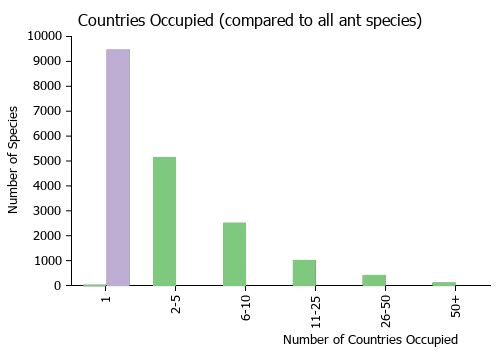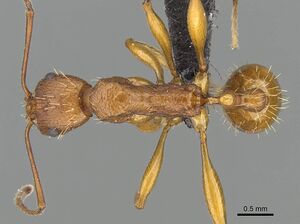Malagidris dulcis
| Malagidris dulcis | |
|---|---|

| |
| Scientific classification | |
| Kingdom: | Animalia |
| Phylum: | Arthropoda |
| Class: | Insecta |
| Order: | Hymenoptera |
| Family: | Formicidae |
| Subfamily: | Myrmicinae |
| Tribe: | Crematogastrini |
| Genus: | Malagidris |
| Species: | M. dulcis |
| Binomial name | |
| Malagidris dulcis Bolton & Fisher, 2014 | |
M. dulcis occurs under stones and in leaf litter samples in rainforest. It has also been discovered in littoral forest, and once in tropical dry forest where it was foraging on the ground.
Identification
Bolton and Fisher (2014) - Apart from Malagidris belti, which has a much broader head, shorter scape, and shorter metafemur (CI > 80, SI < 130, MfL/HW < 1.50), the worker of dulcis is the most setose species of the genus. Its possession of the cephalic setal array described above, combined with 4 mesonotal pairs, including one at the metanotal groove, and at least one pair on the propodeum, render it immediately recognisable. In addition, it is the only species to have the metafemur relatively deep (MfL/MfH 4.60–5.10), a ratio matched only by belti (MfL/MfH 4.62–5.22), and far below those seen in the more attenuated species of the genus, where the collective MfL/MfH is 5.77 to > 12.00.
There is a possibility that dulcis, as presently constituted, includes more than one cryptic species. Of special interest is the variation seen in the degree of elevation of the propodeal spines, and also their length. In terms of elevation the spine in profile varies from about 45° to almost vertical. At present this is not being treated as significant, but the acquisition of more material may necessitate a re-examination. Whatever the elevation of the spine, most specimens have a propodeal spine length of 0.18–0.26. However, there is a single specimen in CASC, collected by P.S. Ward and with collection data noted below, which has a propodeal spine length of 0.38, well above the usual range. This specimen also has a slightly broader head (CI 74), slightly shorter scape (SI 145), deeper metafemur (MfL/MfH 5.50) and a broader postpetiole (length/height ratio 1.05) than is usual. As only one such specimen is available, and because its other characters match the dulcis material, it is retained within dulcis, but this should be re-assessed if similar material is ever rediscovered.
Keys including this Species
Distribution
Latitudinal Distribution Pattern
Latitudinal Range: -12.09949° to -12.09949°.
| North Temperate |
North Subtropical |
Tropical | South Subtropical |
South Temperate |
- Source: AntMaps
Distribution based on Regional Taxon Lists
Malagasy Region: Madagascar (type locality).
Distribution based on AntMaps
Distribution based on AntWeb specimens
Check data from AntWeb
Countries Occupied
| Number of countries occupied by this species based on AntWiki Regional Taxon Lists. In general, fewer countries occupied indicates a narrower range, while more countries indicates a more widespread species. |

|
Estimated Abundance
| Relative abundance based on number of AntMaps records per species (this species within the purple bar). Fewer records (to the left) indicates a less abundant/encountered species while more records (to the right) indicates more abundant/encountered species. |

|
Biology
Castes
Worker
Images from AntWeb
   
| |
| Holotype of Malagidris dulcis. Worker. Specimen code casent0141811. Photographer Michele Esposito, uploaded by California Academy of Sciences. | Owned by CAS, San Francisco, CA, USA. |
Male
Images from AntWeb
     
| |
| Male (alate). Specimen code casent0135071. Photographer Estella Ortega, uploaded by California Academy of Sciences. | Owned by CAS, San Francisco, CA, USA. |
Nomenclature
The following information is derived from Barry Bolton's Online Catalogue of the Ants of the World.
- dulcis. Malagidris dulcis Bolton & Fisher, 2014: 24, figs. 16-18 (w. putative m.) MADAGASCAR.
- Type-material: holotype worker, 6 paratype workers.
- Type-locality: holotype Madagascar: Antsiranana, Ampombofofo, 25 m., 12.09949°S, 49.33874°E, 21-22.xi.2007, BLF 18541(8), littoral forest (Fisher, et al.); paratypes with same data but BLF 18541(1), (2), (4), (6), (7), (9).
- Type-depositories: CASC (holotype); BMNH, CASC (paratypes).
- Distribution: Madagascar.
Unless otherwise noted the text for the remainder of this section is reported from the publication that includes the original description.
Description
Worker
(holotype in parentheses). TL 4.7–5.4 (5.3), HL 1.04–1.28 (1.20), HW 0.75–0.90 (0.82), CI 68–74 (68), SL 1.12–1.38 (1.28), SI 147–160 (156), PW 0.62–0.75 (0.66), WL 1.40–1.70 (1.58) (10 measured).
Mandible with 10–12 teeth and denticles in total, finely longitudinally costulate. Scapes relatively short (SI 145–160), with minute pubescence but lacking standing setae. Club segments of funiculus long and slender, distinctly longer than broad. EL 0.20–0.25 (EL/HW 0.26–0.30). With head in profile the dorsal outline above and behind the eye is more or less flat, or at most only extremely shallowly concave. With head in full-face view sides behind the eyes elongate, shallowly convex and weakly convergent posteriorly; posterior margin very shallowly concave, with a sharp occipital carina that is not raised into a translucent cuticular flange. Dorsum of head predominantly longitudinally rugulose, anastomoses absent or very sparse; posteriorly the rugulae decrease in strength. Spaces between the rugae finely reticulate-punctulate everywhere. Ventral surface of head with very weak, oblique transverse sculpture. Dorsum of mesosoma rugulose to reticulate-rugulose; spaces between the rugulae with weak punctulate ground-sculpture. Propodeal spines in profile variable in length (0.18–0.26) and degree of elevation. In the majority of specimens the spines short, stout and upcurved, with their ventral margins shallowly convex and dorsal margins shallowly concave; in others the spines are more or less straight. Propodeal declivity unsculptured. Side of mesosoma usually with scattered rugulae, but in some these are very reduced; superficial punctulae are present between the rugulae. Metafemur relatively short, MfL 1.28–1.58 (MfL/HW 1.70–1.83), relatively deep in posterior view, MfL/MfH 4.60–5.10. Peduncle of petiole slender, more or less straight to extremely feebly downcurved in profile and with a small, dentiform anteroventral process. Subpetiolar process not followed by a cuticular crest along the mid-ventral surface of the peduncle. Petiole node in profile quite broad, bluntly rounded dorsally, not acute apically. Petiole node with very weak superficial punctulate sculpture, almost effaced in some. Postpetiole in profile shallowly convex dorsally, about 1.19–1.26 times longer than high; in dorsal view distinctly longer than broad; maximum dorsal width of postpetiole ca 0.34–0.43, about equal to its height. Dorsum of postpetiole node finely punctulate. Base of first gastral tergite usually with basigastral costulae effaced, but sometimes vestiges are visible; tergite otherwise unsculptured. Full adult colour yellow to yellow-brown.
Pilosity: with head in full-face view the side in front of the eye with 1–2 projecting setae, the side behind the eye with 4–5 projecting setae, and also with 1–2 setae that project outward from below the eye itself; with head in profile the dorsum behind the highest point with 4–5 pairs of setae that are inclined anteriorly, followed by a transverse row of 4–6 setae closest to the posterior margin; pronotal dorsum with a transverse row of 4 setae anteriorly and 1–2 pairs close to the mesonotal margin; mesonotum with 4 pairs, the posteriormost of which is at the metanotal groove; propodeal dorsum with 1 pair, uncommonly with a second pair also present; ventral surface of metafemur with 1–2 setae, located close to the metatrochanter; petiole node with a pair of setae on its dorsum, another on its posterior face, and another posterobasally; postpetiole with 4–6 setae dorsally and with a row of 4–6 posteriorly; gaster with numerous simple setae.
Male
Putative. Mandible with 6–7 sharp teeth. CI 80, SI 58, MfL 1.10 (1 measured). First funicular segment of antenna 0.55 × the length of the second segment. EL/HW 0.50. With head in profile the dorsal outline behind the posterior ocelli descends vertically to the occipital carina, without a posteriorly projecting prominence or lobe behind the vertical surface. With mesosoma in dorsal view the arc of the pronotum is concealed medially by the anterior bulge of the mesoscutum. Notauli with anterior portions discernible, but shallow and almost effaced. Peduncle of petiole with spiracles not borne on tubercles, in dorsal view the maximum width of the petiole is across the node. Postpetiole in dorsal view 1.39 × longer than broad.
Based on a single male, Madagascar: Toamasina, P.N. Andrasibe, BLF 19394 (Fisher et al.) (CASC). Tentatively associated with the workers of dulcis as the structure of head and mesosoma in the male is very similar to the male of Malagidris belti, the species whose workers most closely resemble those of dulcis.
Type Material
Holotype worker, Madagascar: Antsiranana, Ampombofofo, 25 m., 12.09949°S, 49.33874°E, 21–22.xi.2007, littoral forest, BLF 18541(8), CASENT0141811 (Fisher et al.) (California Academy of Sciences). Paratypes. 6 workers with same data as holotype, but coded: BLF 18541 (1), CASENT0141806; BLF 18541 (2), CASENT0141807; BLF 18541 (4), CASENT0141808; BLF 18541 (6), CASENT0141809; BLF 18541 (7), CASENT0141810; BLF 18541 (9), CASENT0141812 (CASC, The Natural History Museum).
References
- Bolton, B. & Fisher, B.L. 2014. The Madagascan endemic myrmicine ants related to Eutetramorium (Hymenoptera: Formicidae): taxonomy of the genera Eutetramorium Emery, Malagidris nom. n., Myrmisaraka gen. n., Royidris gen. n., and Vitsika gen. n. Zootaxa. 3791:1–99. doi:10.11646/zootaxa.3791.1.1
References based on Global Ant Biodiversity Informatics
- Bolton B., and B. L. Fisher. 2014. The Madagascan endemic myrmicine ants related to Eutetramorium (Hymenoptera: Formicidae): taxonomy of the genera Eutetramorium Emery, Malagidris nom. n., Myrmisaraka gen. n., Royidris gen. n., and Vitsika gen. n. Zootaxa 3791(1): 1-99.

